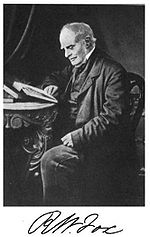
Robert Fox m. Maria Barclay (1785-1858)
Lloyd H Fox was the 2nd cousin 3x removed of Robert W Fox
Griselda Bigland was the 2nd cousin 3x removed of Maria Barclay
source: wikipedia
Robert Were Fox FRS (26 April 1789 – 25 July 1877) was a British geologist, natural philosopher and inventor.
He is known mainly for his work on the temperature of the earth and his construction of a compass to measure magnetic dip at sea.
Life and family
Robert Were Fox the Younger was born on 26 April 1789 at Falmouth, United Kingdom, the eldest son of Robert Were Fox (1754 – 1818) and his wife, Elizabeth Tregelles. He had nine siblings. The Fox family were members of the Religious Society of Friends (Quakers), and were descended from members who had long settled in Cornwall, although they were not related to George Fox who had introduced the community into the county.
In 1814, Fox the Younger married Maria Barclay (1785 – 1858), daughter of Robert and Rachel Barclay of Bury Hill, near Dorking, Surrey. Maria’s sister, Lucy, married Fox’s cousin, George Croker Fox (1784–1850).
Robert Were Fox the Younger and his wife had three children, Anna Maria (1816 – 1897), Barclay (1817 – 1855) and Caroline (1819 – 1871). Both Caroline and Barclay Fox’s journals have been published.
Robert Were Fox the Younger died on 25 July 1877 and was buried at the Quaker Burial Ground at Budock.
Business interests
Fox was involved in many aspects of his family’s businesses, along with several of his brothers. He also served as Honorary Consul of the U.S.A in Falmouth from 1819 to 1854.
Fox and Joel Lean were granted a patent in 1812 for their modifications of steam engines.
Horticultural interests
Fox’s gardens at Rosehill and Penjerrick, near Falmouth, became noted for the number of exotic plants which he and his son, Barclay, had naturalized.
Scientific work
Fox’s work was in what today would be referred to as geophysics. He was distinguished for his researches on the internal temperature of the earth, contributing papers to the Royal Geological Society of Cornwall, and being the first to prove that temperature definitely increases with depth (the geothermal gradient), his observations being conducted in Cornish mines from 1815 for a period of forty years. In 1829 he began a set of experiments on the artificial production of miniature metalliferous veins by means of the long-continued influence of electric currents, and his main results were published in 1836.
In 1834 Fox constructed an improved form of deflector dipping needle compass, or dip circle, for polar navigation. One was used by Sir James Clark Ross on his Antarctic expedition and used to discover the position of the South magnetic pole.
He was a key person in the development of the Royal Cornwall Polytechnic Society and its promotion of scientific research and training. He was an active member of the British Association for the Advancement of Science.
Robert Were Fox, his cousin, George Croker Fox (1784–1850) and brother, Alfred Fox, assembled excellent collections of minerals, which are now in the British Museum (Natural History), given by Arthur Russell.